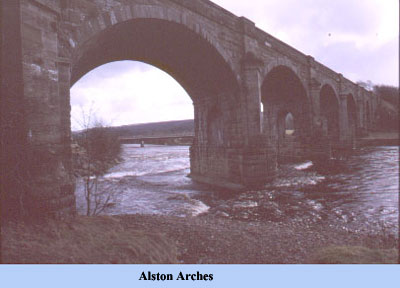
SOUTH TYNE - HALTWHISTLE TO ALSTON

"Below the village (of Lambley) is the spectacular thirteen-arch viaduct of the former Alston Branch of the Newcastle and Carlisle railway 1852"
The Buildings Of England, Northumberland. N Pevsner. 1992
This stretch of river takes us south as the Tyne turns in that direction soon after leaving Haltwhistle. Passing Featherstone with its castle it is crossed by an old arch bridge and a footbridge as it runs between heavily wooded banks and climbs more steeply than before. On past the fairly recently built Diamond Oak road bridge to flow under the spectacularly lofty Lambley railway viaduct, one of the most impressive bridges on the whole of the Tyne. The line of the former Haltwhistle to Alston branch railway is never far from the river on its way up the valley.
The old Eals bridge, the bridge at Williamston near Slaggyford and several footbridges next cross its waters until the Tyne reaches Alston at a height pf of about 275 metres. The Northumberland - Cumbria border is reached about a mile before Alston at Kirkside. This is lonely country with both major and minor roads generally taking a higher elevation than the river, only descending when a bridge beckons. For much of the way the former railway branch line from Haltwhistle has tracked the river's path through the hills, crossing the river only twice. The road too, is not far away, approaching the little town of Alston on the west side of the river, crossed by an old bridge amid converging routes. On all sides are the Pennines, the fells and Alston Moor. Many small streams have joined the main river on its way to Alston and the larger stream of the River Nent joins at the town itself, whose steep cobbled main street and stone, slate-roofed houses line the road together with shops, pubs and public buildings in what is said to be England's highest market town.
- Featherstone bridge - 1778
- Featherstone footbridge - date not known
- Diamond Oak bridge - 1975
- Lambley footbridge - 1954
- Lambley railway viaduct - 1852
- Whitwam footbridge - date not known
- Eals bridge -1733
- Parson Shields Bridge - date not known
- Williamston bridge - date not known
- Kirkhaugh footbridge -date not known
- Alston railway bridge - 1852
- Alston road bridge -17th C

